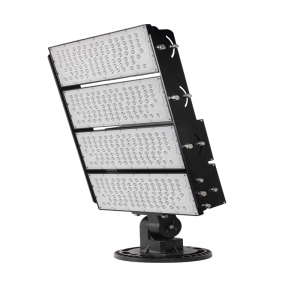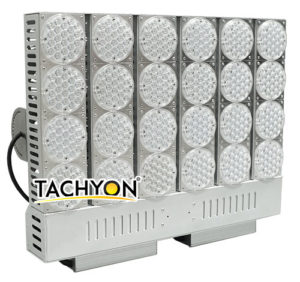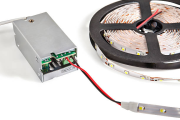What is power factor
Whether it is LED, fluorescent lamp or incandescent lamp, we all need to understand that power factor (PF) is one of its important parameters. Let us talk about what is the power factor.
Power factor represents the ability of lamp to output active power. Power is a measure of energy transfer rate. In DC circuit, it is the product of voltage V and current a. In the AC system, it is more complicated: that is, some AC current loop in the load does not transmit power, which is called reactance current or harmonic current, which makes the apparent power (voltage volt times current amps) greater than the actual power. The difference between apparent power and actual power leads to power factor, which is equal to the ratio of actual power and apparent power. So the actual power in the AC system is equal to the apparent power multiplied by the power factor. Namely: power factor = actual power / apparent power.
Only when the power factor of linear load such as electric heater and bulb is 1, the difference between the actual power and apparent power of many equipment is very small and can be ignored, while that of capacitive equipment such as lamps is very large and important. Recently, a study in American PC Magazine shows that the typical power factor of lamps is 0.65, that is, the apparent power (VA) is 50% higher than the actual power (Watts)!
Apparent power
Apparent power: the product of AC voltage and AC current. The formula is s = UI. Where, s is the rated output power, in VA (volt ampere); u is the rated output voltage, in V, such as 220 V, 380 V, etc.; I is the rated output current, in a. Apparent power includes two parts: active power (P) and reactive power (q). Active power refers to the part that does work directly. For example, make the light on, make the motor rotate, make the electronic circuit work, etc.
Because this power becomes heat after doing work, which can be directly felt by people, some people have the illusion that the active power is regarded as apparent power, and no one knows that the active power is only a part of the apparent power, expressed in the formula: P = SCOs θ = uicos θ = UI · F. Where p is the active power, and the unit is w (Watts); F = cos, θ is called the power factor, and θ is the phase difference of voltage and current in different phases under nonlinear load. Reactive power is the part of power stored in the circuit but not directly working
Q=Ssinθ=UIsinθ。 Where q is reactive power in var.
Reactive power
For lamps and all other electronic circuits which depend on DC voltage, it is impossible to work without reactive power. General users think that the equipment like lamps only need active power, but not reactive power. Since reactive power does not work, what is the use of it! So of course, they think that the lamp with power factor of 1 is the best. Because it gives the maximum output power. However, this is not the case.
If there is a lamp, when the AC power input is rectified, the pulsating DC voltage will be obtained. If the pulsating voltage is not processed, it will be directly supplied to the lamp. There is no doubt that the circuit can not work normally. Although the power factor of the lamp is close to 1, what’s the use of this. In order to make the lamp circuit work normally, a smooth DC voltage must be provided. This “smoothing” must be done by a filter capacitor connected behind the lamp rectifier.
This filter is like a reservoir. There must be enough charge stored in the capacitor to keep the working voltage on the circuit uninterrupted and maintain normal level when there is a gap between the rectifier half waves. In other words, even when there is no input power between the two pulsating half waves, the voltage level of UC does not change significantly. This function is realized by the energy storage in the capacitor, which is the reactive power. Therefore, the lamp depends on the support of reactive power to ensure the correct use of active power in the circuit to achieve normal operation making it easy to use. Therefore, it can be said that lamps need not only active power, but also reactive power.
Power factor of various lamps
We know that the incandescent lamp is actually a pure resistance, so its power factor is of course equal to 1. But this is not the case with the more and more widely used fluorescent lamps and the energy-saving lamps that have been vigorously promoted by the country.
For a long time, fluorescent lamps have relied on a large inductor and a starter to start. After lighting, the large inductor is connected in series in the circuit. So it is basically an inductive load, and its power factor is only 0.51~0.56. In the future, electronic ballasts will have better power factors, but because electronic ballasts are easy to burn out, inductance is the most used Ballast.
The power factor of energy-saving lamps is only about 0.54, and it is also an inductive load.
Power factor of LED lights
Because LED is a semiconductor diode, it needs DC power supply. If it is powered by city power, there must be a ballast, which is usually a diode ballast bridge. In order to avoid ripples and flicker and get as smooth DC as possible, it is usually necessary to add a large electrolytic capacitor, and the following LED can be approximated as a resistor.
The voltage and current waveforms after rectification are not sine waves, and although the voltage waveform before rectification is sine waves, the current waveforms are not sine waves either. Therefore, the entire system is a non-linear system, and the original power factor is defined for a linear system, and the input and output voltage and current are required to be sinusoidal with the same frequency, otherwise cosφ cannot be used. But in a non-sinusoidal system, because the voltage and current waveforms are not sine waves, there is no phase angle that can be said. Therefore, the power factor in a nonlinear system must be redefined.
As mentioned earlier, another definition of power factor is the ratio of active power to apparent power. Active power refers to the actual output power, and apparent power refers to the product of the effective value of the input voltage and the effective value of the input current. This is completely equivalent to cosφ in the sine wave system, so there is no problem. But in a nonlinear system, what is effective power and what is apparent power is worth re-discussing. Because in a non-linear system, the current waveform has many high-order harmonics, it is a big question as to what to use as the apparent power.
There are several common practices now:
1.Multiply the effective value of the fundamental wave of the current and the effective value of the sine voltage as its apparent power, or use the cosine value of the fundamental current phase as the power factor, or use the cosine value of the zero-crossing phase of the current waveform as the power factor Power factor is measured in this way by some instruments. It can be seen from the current waveform that the high-order harmonics of this waveform are very rich, and its fundamental wave is very small. If the fundamental wave current is multiplied by the fundamental wave voltage, the power obtained is very small relative to the effective power. , So its power factor will be very high, and may even be greater than 1, such as some analog power factor meters.
- Multiply the effective value of the voltage and the effective value of the current as the apparent power. Nowadays, many digital power factor meters use the multiplying of the effective value of the voltage and the effective value of the current as the apparent power. The effective value of non-sine wave current can be expressed by the root mean square value of each harmonic current:
If the power factor is defined as the ratio of actual power to apparent power:
The harmonic distortion is usually defined as:
Many current digital power factor meters are basically defined in this way.
But the definition of power must be the product of the effective voltage value and the effective current value of the sine wave of the same frequency. The product of the effective value of the current higher harmonics and the effective value of the fundamental voltage cannot be regarded as power, because its frequency is different, so it is a meaningless number. So using this method to define apparent power is problematic. Unfortunately, many digital meters now measure in this way.
In fact, this problem has always existed in academia. In the case of non-linearity, a variety of different definition methods have been proposed for the power factor. The same non-linear system can get completely different power factor values under different definitions, and no matter which definition it is, it None of them are in line with the original intention of proposing power factor in linear systems. For example, in a linear system, as long as pure capacitance or pure inductance is used, inductive or capacitive loads can be compensated, which is obviously unattainable in a nonlinear system. Therefore, these defined power factors completely lose their original meaning.
In fact, in the case of non-linear loads, the biggest problem is the harmonic current, because although the harmonic current and the fundamental voltage cannot form the apparent power, the square of the harmonic current multiplied by the line resistance will cause heat loss. Moreover, this kind of harmonic current cannot be compensated by simple capacitors or inductors. Therefore, what really needs to be limited is the harmonic current value, not the so-called “power factor”.
The most important thing in scientific development is sustainable development, and the most important thing is energy saving and emission reduction. For all new technologies that contribute to energy conservation and emission reduction, the world should give strong support. LED is one of the most important items. Some countries once distributed an energy-saving lamp to every household for free to replace the incandescent lamp. However, energy-saving lamps are far from being compared with LEDs because of their low light efficiency, mercury pollution, and fragility. Now that LED has matured day by day, countries around the world should support and promote vigorously from all aspects with greater efforts.











